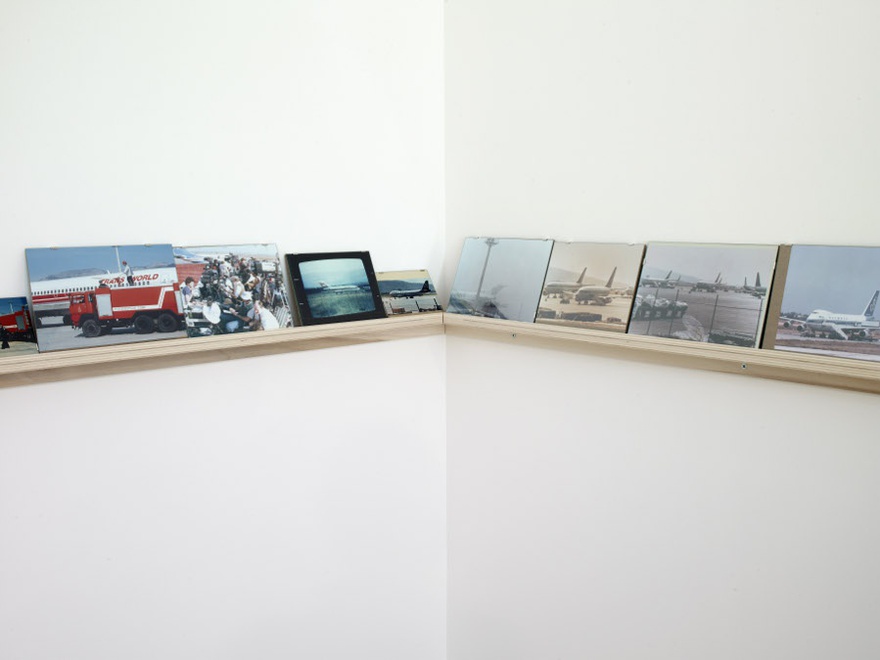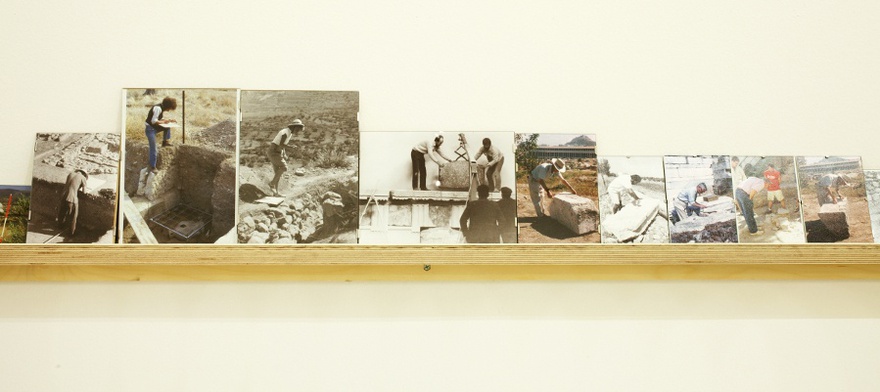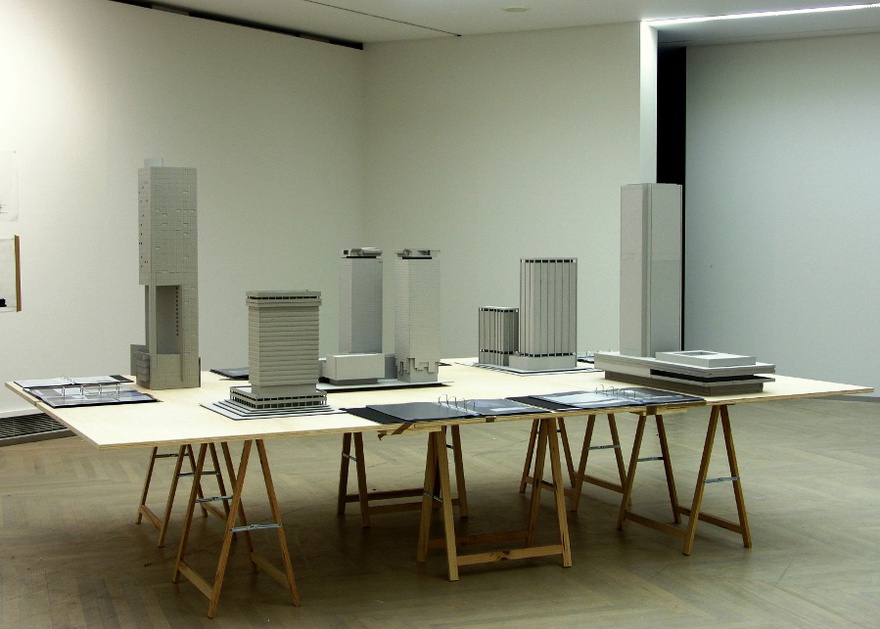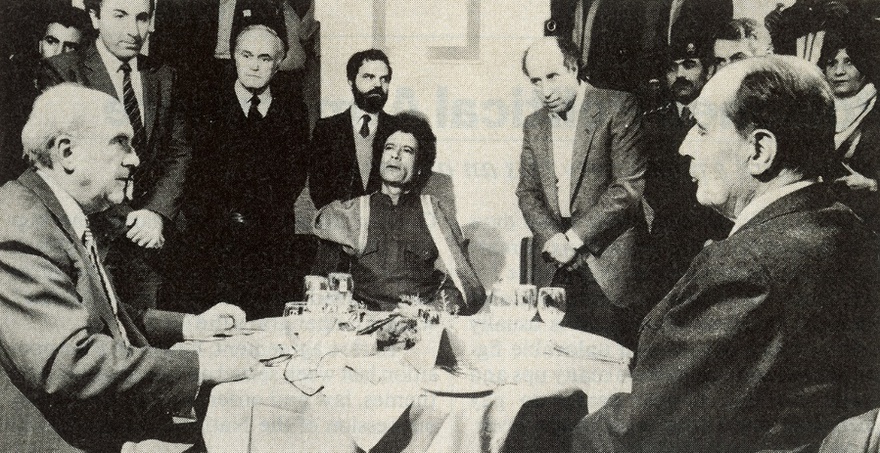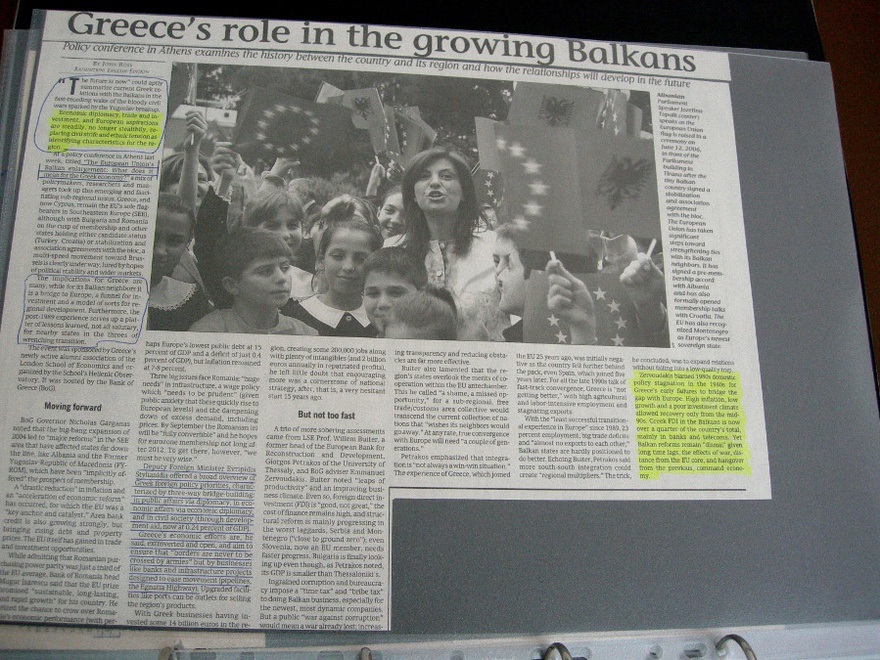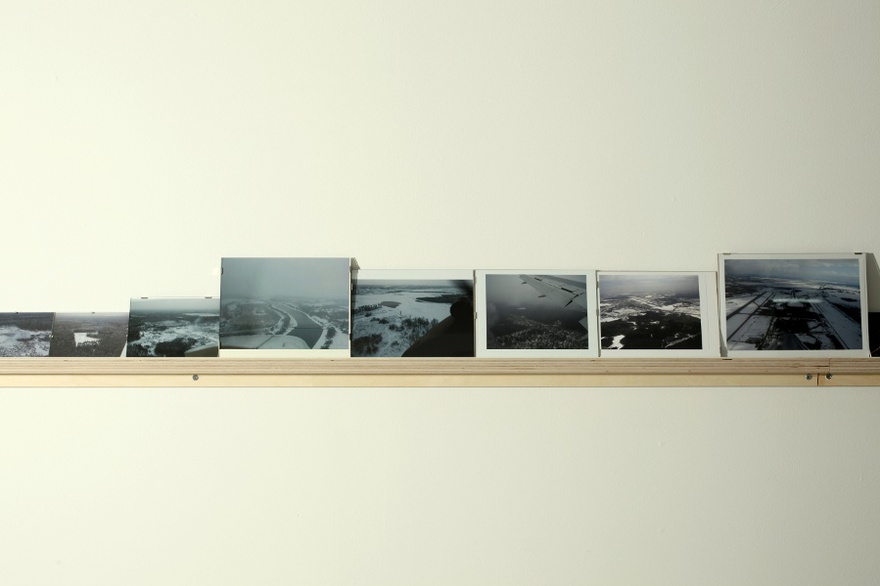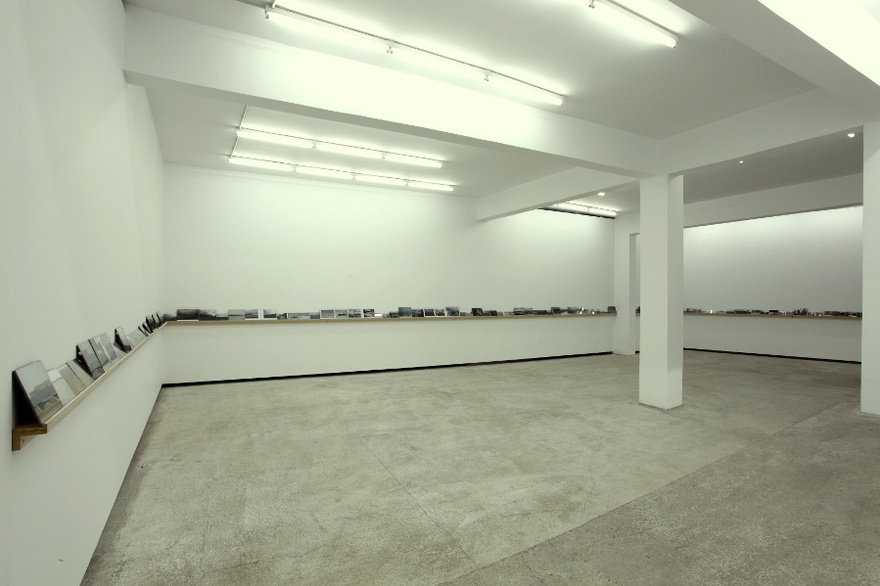Interviews
A Cartography of Events
Vangelis Vlahos in conversation with Stephanie Bailey
Vangelis Vlahos's work mines archives so as to produce geopolitical perspectives of historical events. Through archival research into specific historical frames, he considers Greece's role not as a peripheral nation, but as a nodal point through which global flows pass, driven by the forces of various interests – trade being one of them. Here, history is taken as a series of moments, from a meeting between Muammar Gaddafi, Francois Mitterand, and Andreas Papandreou in Crete in 1984, to the accumulation of images depicting aircraft grounded in Greece for non-technical reasons from the 1970s to early 2000s. In this interview, Vlahos discusses the way his archival projects deal with the question of history and the challenge of mapping global relations through the assemblage of archival documents and objects.
Stephanie Bailey: You have said that your work produces a kind of amateur archeology, through which you unearth narratives that link Greece to the wider world, from the Balkans to the Middle East and Africa. For one project, Foreign archaeologists from standing to bending position (2012), you collected fifty three portraits of archaeologists who have worked in Greece over the last years from the archives of various Athens-based foreign archaeology schools. The project is a multi-layered story told 'within the bounds of modern Greek history', in which, as Daphne Vitali writes, 'Greece's current status as a nation under scrutiny by foreign technocrats, economists, and politicians is mirrored' through the figure of the foreign worker 'coming to Greece to undertake and supervise work on a certain project: comparable to the economic restructuring taking place in the country today.'
But before we go into the Platform 008 theme and discuss the relations you build between Greece and the Global South, I wanted to discuss how you unearth histories through your earlier projects, such as Athens Tower (Tenants Lists 1974–2004) (2004), Buildings like texts are socially constructed (2004) and Buildings that proclaim a nations identity to the world should not be misunderstood (2003), "1992" (THE RENOVATION OF THE BOSNIAN PARLIAMENT) (2006–2007). These projects concentrate more on Greece's relationship with America and Eastern Europe. I wonder if you could firstly introduce how your practice developed at the outset through these early projects, and for what reasons and purposes?
Vangelis Vlahos: Archaeology as a practice producing narratives and meanings out of material traces of the past is a good way to describe the way I try to appropriate different political and social realities of the recent Greek history. I first engaged with subjects concerning these realities from the field of architecture aiming mostly to understand the discipline's ideological and historical framework. In this context, in 2004, I conducted research around the Athens Tower, the first skyscraper built in the International Style during the colonels' regime (1967–1974), and which is still the tallest building in Greece. As part of the project, I listed the tenants of the Athens Tower between 1974 and 2004, and in the process, recorded the shift from big state-owned and American companies to small Greek firms. The work not only speaks to Athens Tower's status throughout this particular period, but it also aims to examine the political visions projected onto it.
Later, I extended this research to other high-rise buildings from the broader Balkan region. In Buildings Like Texts Are Socially Constructed (2004) and New Markets Require New Structures (2005), the construction of the architectural models of these high-rises was entirely based on unconfirmed information found in discussions in online forums among people who share an amateur passion for high-rise buildings. Therefore, although the models are made by professional architects and appear accurate, they do not correspond closely to the actual buildings to which they refer. Also their 'neutral' modernistic 'shell' does not say much about their geography and context. They are reminiscent of corporate buildings that one can easily find in any Western European city. Most of these buildings, which were built in the 1970s following a more western architectural style and originally were state-owned, were renovated and sold, or leased to private and foreign companies after the transition to market economy in the 1990s.
The last project of this series,"1992" (THE RENOVATION OF THE BOSNIAN PARLIAMENT) (2006–2007), refers to the renovation of the Bosnian Parliament in Sarajevo, a rationalist high-rise building from the 1970s which was destroyed during the war in Yugoslavia in the 1990s and renovated with Greek funds in the mid 2000s.The project consists of two models and an archive which apart from information on the reconstruction works, includes information on economic agreements between the two countries as well as the Greek foreign policy activities in the region since 1992. The construction of the two models was made by two different groups of architects. One model used the official architectural plans of the company that was responsible for the rehabilitation, while the other was restricted to photos found on the Internet in which the building is depicted destroyed.
SB: Then your projects started to explore the archive through images, such as "1981" (Allagi) (2007), which considers the first months of the administration of the Socialist Party in Greece, Pasok, against the history of the country's military dictatorship, the so-called Regime of the Colonels, which lasted from 1967 to 1974.
VV: My more recent projects take the form of collections of found photographs building up a network of references and relations which aim to test the possibility of seeing and understanding different events and conceptions of the past outside the official narratives. 1981 "Allagi" (2007) is an early example of one of these projects. The word Allagi (change) was the main political slogan of the 1981 election campaign of the Greek Socialist Party. The project tries to construct a reading of the first nine months of the Socialist Party's administration in the early 1980s through visual material found in the archive of the Eleftheros Kosmos newspaper, the official mouthpiece of the Regime of the Colonels. The material of the project covers the period from the time the Socialist Party won the elections in October 1981, to the time the newspaper closed in June 1982. I organized the images like a calendar: chronologically according to date.
SB: You made Grey Zones, which considers America and the Soviet Union's influence in Greece during the Cold War, the same year you made The Elounda Summit (The differences between the parts are the subject of the composition): in 2009. The latter work, which has been reinterpreted for the online space as part of Ibraaz Platform 008 projects, presents images taken by Greek and foreign media present at a summit meeting between Greek Prime Minister Andreas Papandreou and Muammar Gaddafi and Francois Mitterand held at Elounda Bay on the island of Crete on 15 November 1984. The purpose of the meeting was to discuss bilateral troop withdrawals from Chad, which Papandreou personally mediated. Could you talk about how this project came about, and why you felt the need to investigate this moment at that time? In many ways it links to what you have mentioned before: the Greek government, after the fall of the dictatorship in the 1970s, has traditionally pursued a policy of friendship, asserting an intermediary, geopolitical role as a crossroads in the region.
VV: The Elounda Summit and Grey Zones projects explore themes relevant to concepts of economic and political expansionism. Both focus on the role or roles that Greece – with its uneasy place between Europe, the Eastern Mediterranean and North Africa – has played in a larger political economy. Grey Zones consists of two sets of photographs found in local newspapers, which refer to two Greek attempts to utilize the Aegean Sea in the 1970s. The first set of images involves an American drill-ship that was used for the exploitation of Aegean's oil fields while the second, a Soviet auxiliary vessel that inaugurated the bilateral agreement between Greece and Russia in order for the Russian Navy to use the Greek shipyards in Syros Island for repairs. Both were short-lived ventures that now exist only as vestiges of the Greek state's efforts to develop a modern economy around the Aegean. These two initiatives like, Andreas Papandreou's personal 'mediation' between France and Libya, never fulfilled the political and social expectations created originally in the 'Elounda Bay Agreement' in 1984.
SB: Which brings us to The Elounda Summit (The differences between the parts are the subject of the composition).
VV: In that project, this historical encounter between Papandreou, Gaddafi and Mitterrand is seen in the context of Andreas Papandreou's policy at the time to make Greece 'the bridge' between Europe and the broader Middle East. A series of photographs taken at this event showing Papandreou, Gaddafi and Mitterrand seated around a table serve to remind us of Papandreou's initiative for Greek mediation in the conflict between France and Libya, which ultimately led to a compromise between the warring parties the two countries supported in Chad. The photos depict the same scene from different angles. The different shots are ordered in such a way in order to construct a sequence that follows the scene of the three leaders clockwise. The photos have slight changes with regard to gestures or the position of those depicted.
SB: The Elounda project feels representative of your conceptual approach, in which you explore history's footnotes; unearth forgotten or little known stories.
VV: Often, I look at small events and moments from the recent past, which I try to connect and understand in a broader context. With the Elounda project, I tried to explore Greece's relations with the Arab world taking as a starting point an event I had blurred memory of. I was concerned less with re-creating or re-narrating the particular meeting than with testing its impact from today's point of view. What we see and what we are able to interpret is only a fragment of something bigger and more complex.
SB: Could you explain the Elounda project's subtitle, which is based on a found sentence from Sol LeWitt's text Serial Project No.1 (ABCD), Aspen Magazine, 5–6 (1966)?
VV: Sol LeWitt's sentence could be seen as a supplemental clue that can help the viewer to ponder the relationship of the parts to the whole and to derive the underlying narrative of the material. A narrative connected mainly to Greece's foreign policy in the Middle East during the 1980s, which we could say tried at that time to make perfectly clear that Greece should no longer be considered a submissive satellite of the western world.
SB: Aircrafts on the Ground (2009–2010) is a project that points to Greece's literal, geographical position as a mediatory space. Inverting the aviation term for aircrafts grounded for technical reasons, the project shows images of aircrafts grounded in Greece for non-technical reasons from the 1970s to the early 2000s: reasons beyond technical control, including terror threats and hijackings. Could you talk about this project, and how you decided to investigate the history of grounded aircrafts in Greece? What kind of stories did you unearth?
VV: Collecting images of aircrafts that had been photographed on ground for whatever reason in Greece was a good exercise to examine the narrative possibilities of such an abstract subject. In the course of a year of collecting, I found about 57 images of different aircrafts from all over the world that had been grounded in Greece between the late 1960s and early 2000s. The material collected consisted of images involving different incidents, from hijackings to bad weather conditions, covering a period of political and social transition, from the Greek military junta and the period after it, which is known as 'metapolitefsi' to the socialist governments of the 1980s and 1990s. The images are presented on a shelf in chronological order without any information about their original context. Also no dramatic images are included.
My aim was to try to look at this transitional period through a subject that seems to have no direct connection to it, even if an aircraft represents an object that literally is connected with the concept of transfer. During the collecting process I found a photo of the aircraft that transferred fugitive Greek banker George Koskotas from the United States to Athens, on 1 July 1991, to face fraud and forgery charges in a scandal that dominated the Greek political scene in late 1980s and the beginning of the 1990s. This photo led me later to make a project related to him, and recreate the journey he took when he was brought back to Greece to stand trial.
SB: Yes, this project explores the journey Koskotas took when he returned to Greece from America to face charges. There is another project that explores a journey made by another controversial figure: Abdullah Ocalan. IS THERE ANY OVERSIGHT ON OCALAN? (2009–2011) and REMAINS (2011) both explore the story of when Ocalan's capture outside the Greek ambassador's residence in Nairobi on 15 February 15 1999 by the Turkish authorities. The project retraces the supposed route Ocalan took before his capture, from Moscow, Rome, Athens and Minsk to Nairobi, while the latter explores the aftermath and fallout politically in Greece, which, at the time, was trying to meet the requirements to join the new common European currency…
VV: Ocalan's arrest and the degree of Greek complicity in the case caused a major crisis in Greece at that time, three ministers resigned and the stock market dipped two percentage points amid general dismay at the debacle and fears that the government would be destabilized. Nevertheless, the financial and political impact of the Ocalan affair in Greece was not as significant as it seemed at the beginning. After the first shock, the stock market went back to the point it was before. The Remains project focuses on the period after the capture of Ocalan and the crisis caused in Athens by it. The project follows for ten days the coverage by the Greek media of Theodoros Pangalos, Greek Foreign Minister at the time, juxtaposing it with articles related to the Greek economy and the stock market's configuration over the same period. All the material is ordered chronologically and arranged like a calendar, by day.
IS THERE ANY OVERSIGHT ON OCALAN? was built through images found on the Internet and tourist catalogs of that time. It attempted to recreate Ocalan's known and rumoured route before his capture in Nairobi. I installed the photographs on a shelf, which aims to create a kind of timeline of all the places where Ocalan tried unsuccessfully to find political asylum. Given that photographic evidence of the route is minimal, research for the Ocalan project was based on only a few written testimonies of people who at some point encountered Ocalan in the four months before his arrest. From these testimonies, I only used details related to the backdrop of the journey that had to do mainly with the weather conditions, the time and landscape features. None of the images depict Ocalan himself or make any direct reference to the Kurdish issue or Greece's involvement in the case. Without the event, the images are a series of common images of different landscapes, different type of buildings, airports and animals. We have to know the connection between the images in order to 'read' the material. The viewer will not understand the relation of the images before he reads a short text accompanying the work. The viewer can walk by the shelf and follow the route.
SB: There is always a sense of a journey in your projects: the mapping out of a relationship through actual bodies and forces in the world. This culminates in one of your latest projects, Hellas-Syria Express Line, which refers to a trade agreement between Greece and Syria during the seventies that resulted in the establishment of a direct ferry service between the Greek port of Volos and the Syrian port of Tartus. In terms of the Ibraaz Platform 008 question, which is to consider the historical and contemporary relationships between North Africa, the Middle East and the Global South, where do you see Greece fitting in when thinking about the way the Syria-Volos Ferry project maps a relations between Greece and the region?
VV: In Greece there is a vast unconscious repository of representations of the Middle East determining the way we see and understand the context of this particular region. For the people of my generation, growing up in the '80s, no matter how apolitical they may be, it is rather likely they can recall moments that refer to these moments in which Greece's close relationship with the Arab world was expressed. They might have heard of Papandreou's meetings with leaders of the so-called Independent world, or have seen photographs of him shaking hands with Palestinian leader Yasser Arafat. However, Greece's diplomatic and economic involvement in the Balkans and East Europe and its effort to become part of the European Monetary Union – the 'hard core' of the European integration process during the late 1990s and early 2000s – resulted in a gradual neglect of the Middle Eastern and Mediterranean dimensions of Greece's foreign policy.
Today, because of the unstable political situation in the Middle East and the economic crisis in Greece, it is probably difficult for Greece to regain its role and influence in the Eastern Mediterranean region. Nevertheless, Greece's geographical and cultural proximity to this area could play, under specific circumstances, the role of a bridge between the Global West and South – the Eastern Mediterranean region. Of course, the concept of the bridge is not something new; it has been used on different regional initiatives in the past without much success. An example in this context is research I am doing right now that refers to a trade agreement between Greece and Syria that was made during the seventies, which established a direct truck-ferry service between the Greek port of Volos and the Syrian port of Tartus. This was the time when Greece was trying to play an intermediary role between the Middle East, North Africa and the European Community hoping to become a crossroads in the region. The Volos-Syria ferry service was part of a broader trade route connecting a large part of Europe to Middle East and the Arab world and at the time was considered quite important for the transportation of commercial goods at the particular region. However during the eighties the link was heavily affected by the Iran-Iraq war, which significantly shrunk the market and led to the ceasing of the line in July 1988.
SB: In thinking about all the projects we discussed, I wonder if you might tell me what you have learned through these investigations when it comes to considering history and its events?
VV: From my experience, quite often people expect that an artwork, under the current political circumstances, should give history lesson. Or the artist is expected to take on the role of historian or political analyst, which I find problematic. I am not really interested in engaging with issues considered urgent because of their timeliness. I don't want to present myself as an authority on situations that I don't understand or know well. I always took on the perspective of an outsider, or foreigner: someone who does not have a complete picture or a comprehensive knowledge of the events being researched. I think this lack of knowledge has helped me many times in terms of taking a more instinctive and distant approach to otherwise loaded subjects. The possibility of mistakes, misunderstandings, or confusion is part of this process and can be an interpretive tool when it comes to the interpretation of the past. For me, looking back into history – even history's neglected moments – is part of a learning process: an exercise in personal understanding.
See The Elounda Summit (The Differences Between The Parts Are The Subject of The Composition) project on Ibraaz: http://www.ibraaz.org/projects/108.
Vangelis Vlahos was born in 1971 in Athens, Greece where he lives and works. He has been included in the following exhibitions: Europe / South East. Recorded Memories, The Museum of Photography Braunschweig (2013); Current Pasts, Project Room of National Museum of Contemporary Art – EMST, Athens (2012); Under Construction, Colecção Teixeira de Freitas, Tenerife Space of Arts, Santa Cruz de Tenerife, Canary Islands, Spain (2011); MONODROME, 3rd Athens Biennial, Athens (2011); The End of Money, Witte de With, Rotterdam (2011); To the Arts, Citizens!, Serralves Museum of Contemporary Art, Porto (2010); tanzimat, Augarten Contemporary, Vienna (2010); The Politics of Art, National Museum of Contemporary Art, EMST, Athens (2010); Practicing Memory-in a time of an all-encompassing present, Cittadellarte, Italy (2010); 11th Istanbul Biennial, Istanbul (2009); After Architecture, Centre d’Art Santa Monica, Barcelona (2009); ISLANDS+GHETTOS, NGBK & Kunstraum Kreuzberg/Bethanien, Berlin (2009); Monument to transformation, City Gallery Prague, Prague (2009); Deste Prize, Cycladic Museum of Contemporary Art, Athens (2009), Selective Knowledge, ITYS, Institute for Contemporary Art and Thought, Athens (2008); 27th São Paulo Biennale (2006); Behind Closed Doors, Dundee Centre for Contemporary Arts, Dundee (2005); Manifesta 5, San Sebastian (2004) and the 3rd Berlin Biennial (2004).

